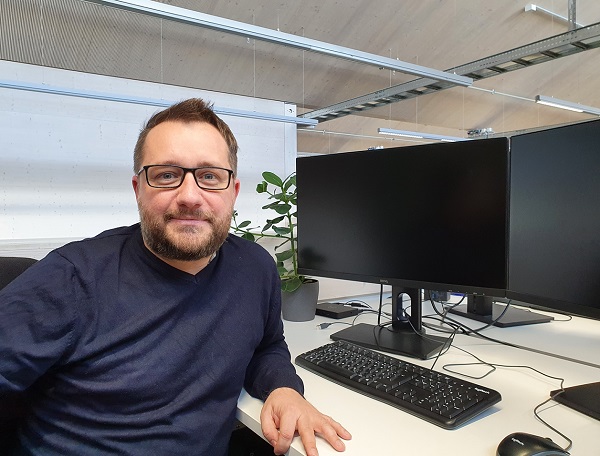There is a lot going on at the LIT Open Innovation Center. We would like to introduce some of the departments and companies working here. Today we are talking with Dominic Girardi of datavisyn.

How does datavisyn benefit from the OIC?
Dominic Girardi: We are a young company so we really like the open office concept and communication opportunities with other companies, research institutions and JKU research labs. Although we have no potential customers here at the OIC (we work in pharmacological R&D), contact to others working at the OIC is very valuable on many levels. I can, for example, remember some truly inspiring conversations about open-source software and matching business models, often spontaneously during lunch in the kitchen area.
The related content and close proximity to the Johannes Kepler University is also very important to us. On one hand, our CEO and JKU professor, Marc Streit, and his research group work just within walking distance from us over at the Institute for Computer Graphics. On the other hand, we want to, of course, be able to attract young, bright minds currently studying at the JKU. Some of our employees are still earning their degrees and they enjoy the opportunity to switch easily between work and studies.
What makes datavisyn unique? What is datavisyn's USP?
Dominic Girardi: datavisyn is unique as we combine international, cutting-edge research together with industrial applications in an enormously complex and sensitive area: drug development.
datavisyn was created at the end of 2016 by researchers from the Johannes Kepler University, the University of Utah, and Harvard Medical School. The corresponding research labs have an international reputation in the field of data visualization in the bio-medical environment.
We apply our expertise to one of the most sensitive areas at any pharmaceutical company: base-knowledge research. This is the area that decides what will be a success or a failure and this to the tune of billions of euros. It’s not easy for a small start-up company to get a foothold in this sensitive, high-tech area.
Our team’s strengths include a general high level of quality as well as the way our company is put together. A large part of the team is recruited from the visual data science research community. They not only possess technical skills (on a graduate and/or PhD level), but also deep domain expertise in the field of bioinformatics. We need this because we work at a high customer expectation level so we not only have to keep pace, we have to actively contribute.
What is currently your favorite project?
Dominic Girardi: Two focal points have emerged for us over the past two years: knowledge retrieval and knowledge discovery. The area of knowledge retrieval includes building systems for our customers that allow them to pull together and visualize all of the available knowledge - whether it’s publicly accessible, top secret, structured data, or image and text material - about specific genes, proteins, cell lines and the like. The area of knowledge discovery aims to build systems that allow our users - chemists, biologists, and geneticists - to understand very large and complex research data and find the targets for tomorrow's drugs. As part of the latter, we have just started a project in which we are at the origin of creating new drugs. Automation is used through so-called high-throughput screening to test millions of molecules and find out which of them have the potential to become a drug. This is really about finding a needle in a haystack. Our part is to meet the challenge to process several gigabytes of data volume per experiment in a way that allows our users to perform a fluid, fast, and interactive analysis. We often have to dig deep into our bag of tricks and think out of the box.
What opportunities does the OIC offer research and JKU Linz?
Dominic Girardi: This combination of research labs, start-up companies, large and established companies, and supporting institutions (such as tech2b or the WKO) is enormously fertile ground for new ideas, innovative solutions, and successful ventures. In my opinion, everyone involved benefits. Conducting research at the JKU offers opportunities to acquire deeper insight into industrial problems and working methods in its own antechamber, so to say. While university research should not be limited to "working for" local industry, easier access to real-world problems, real-world experiences and – something that is becoming increasingly important – real-world data - is enormously valuable in order to support research, including base-knowledge research.
 Go to JKU Homepage
Go to JKU Homepage








